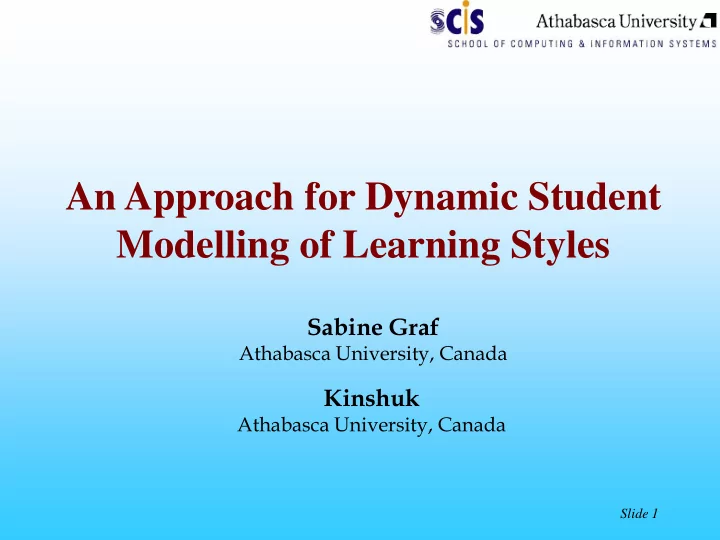

An Approach for Dynamic Student Modelling of Learning Styles Sabine Graf Athabasca University, Canada Kinshuk Athabasca University, Canada Slide 1
Why modelling students’ learning styles? • Benefits of knowing students’ learning styles: – Make students aware of their learning styles – Make teachers aware of their students’ learning styles – Basis for providing adaptivity based on learning styles Slide 2
Types of Student Modelling • Collaborative vs. Automatic – Collaborative: asking students directly for feedback – Automatic: infering students’ characteristics from their behaviour and actions • Static vs. Dynamic – Static: once from a particular amount of data – Dynamic: frequently updating the student model based on new data Slide 3
Aim of Research • Recent research deals with automatic & static student modelling of learning styles (e.g., Cha et al. 2006, Garcia et al. 2007, Graf et al. 2008) • Focus of this paper is on automatic & dynamic student modelling of learning styles • Concept is based on the Felder-Silverman learning styles model but can also be applied for other learning style models with similar structure after few revisions Slide 4
Concept for Dynamic Student Modelling • We assume that certain amount of data is available (in the beginning very few) and that data are frequently added • A main issue is to frequently check whether the new information about students’ behaviour hints for revising the information stored in the student model • Two objectives: • The currently stored learning style should reflect the current learning style of students as good as possible updating as soon as a revision can be done • Considering deviations of students’ behaviour and having as less as possible revisions which are then taken back shortly afterwards Slide 5
More graphically … 1 1 0.9 0.9 0.8 0.8 0.7 0.7 Learnign style Learning style 0.6 0.6 0.5 0.5 identified 0.4 0.4 stored 0.3 0.3 0.2 0.2 0.1 0.1 0 0 1 3 5 7 9 11 13 15 17 19 21 23 25 27 29 31 33 35 1 3 5 7 9 11 13 15 17 19 21 23 25 27 29 31 33 35 Data points Data points Slide 6
Concept for Dynamic Student Modelling • Step 1: Learning styles (data points d t ) have to be calculated based on students’ behaviour in the course at particular points of time t • Step 2: In order to consider deviations in students’ behaviour, the calculation of the current learning style is based on the means of the last A data points. However, one single data point should not have enough influence to force a revision Slide 7
Concept for Dynamic Student Modelling • Step 3: Make decision on whether the currently stored learning style should be revised – Difference between stored learning style and average learning style from current and past data – Difference between currently identified learning style (d t ) and previously identified learning style (d t-1 ) – Compare difference between previously identified learning style (d t-1 ) and stored learning style as well as the difference between currently identified learning styles (d t ) and stored learning style t ∑ t − ∑ d d i i x − 1 < = = − + = − + ≥ − − − > If AND AND NOT THEN i t A 1 i t A 1 d d 2 x L L x d L d L − − t t s s t 1 s t s A 2 A Slide 8
Verification of the Approach • Using data from 75 students from a course about object oriented modelling at a university in Austria • 1. Experiment: What is the best parameter setting? Amount of data points included in the calculation process of learning styles ( A ) 2 3 4 5 1/22 0.521 0.563 0.588 0.602 Accepted differ- learning styles (x) lated and stored ence bet. calcu- 1/11 0.640 0.656 0.645 0.617 2/11 0.615 0.584 0.558 0.532 Slide 9
Verification of the Approach 2. Experiment: Verification of composition of the formula for deciding whether a revision is necessary (Are all three conditions necessary?) x=1/11, A=3 only first condition 0.646 first two conditions 0.642 all three conditions 0.656 Slide 10
Conclusions and Future Work • Developed a concept for automatic & dynamic student modelling of learning styles that revises the learning styles stored in the student model frequently • Revisions are necessary, when learning styles change and if dynamic student modelling is used for improving and fine-tuning the information in the student model • Verified the concept with data from a course with 75 students • Future work: – Implementing the concept in an adaptive learning system Slide 11
Recommend
More recommend